November has been a savage month in the garden here , rainy , depressing , wet and fallen leaves everywhere and I have had to kick myself some days just to go out and do essential tasks … valium anyone ?!!
Of course the leaf colour is fabulous at this time of year but the older I get the more I enjoy autumn colours from inside a window and I am not choosy that it be it from the house or from inside the car !
Still the sight of a birch or maple tree in full autumn colour is stunning and as I write in late November our single liquidamber tree is still full of leaves which will slowly turn to flaming red … a native of China the liquidamber is also know as sweetgum in the US where it grows along the east coast , it is the last tree to leaf up in the spring the last to drop it’s leaf in winter and the deeply grooved cream bark is also spectacular in late winter when all it’s leaves are gone .
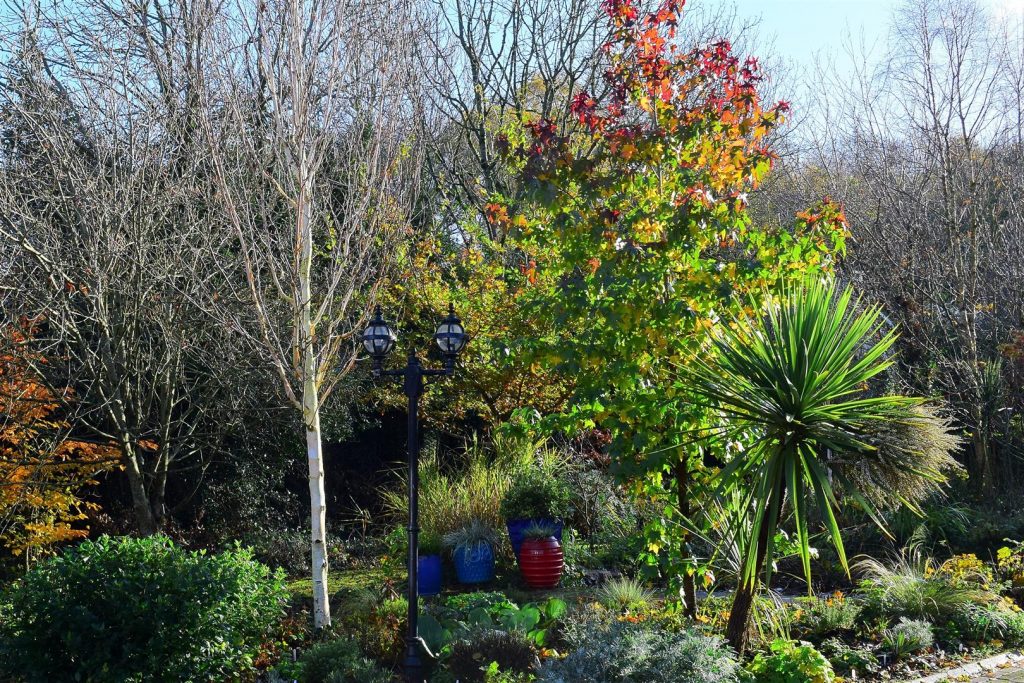
Autumn colour in the garden

We are a long way from olive trees in an Irish November and I mentioned last month how I lost a mature lavender to too much watering on my part plus a small olive I grew here in a pot but the next photo from a visit to Provence shows just how well olive trees and lavender complement each other.
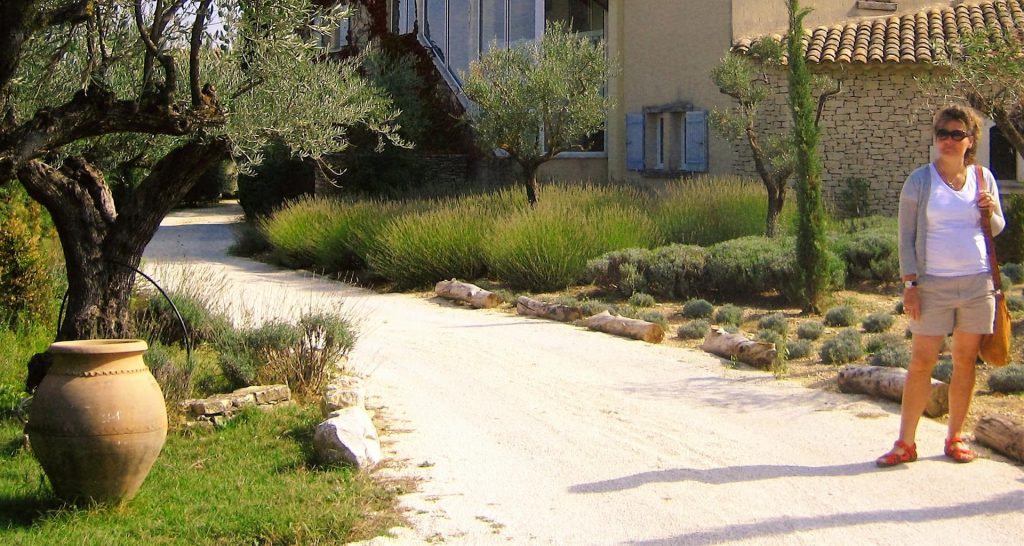
That most glorious of plants , the giant gunnera , dies badly in November and it’s huge leaves need to be tidied up as the first frost reduces them to blackened stumps . I grow a lot of gunerra here and it is two days work to cut off the leaves and fold them into themselves and this does two jobs , it tidies the gunnera into nice parcels which in themselves are a design feature but also the big leaves cover the tender bracts of the plant and keep them nice and snug for the winter .
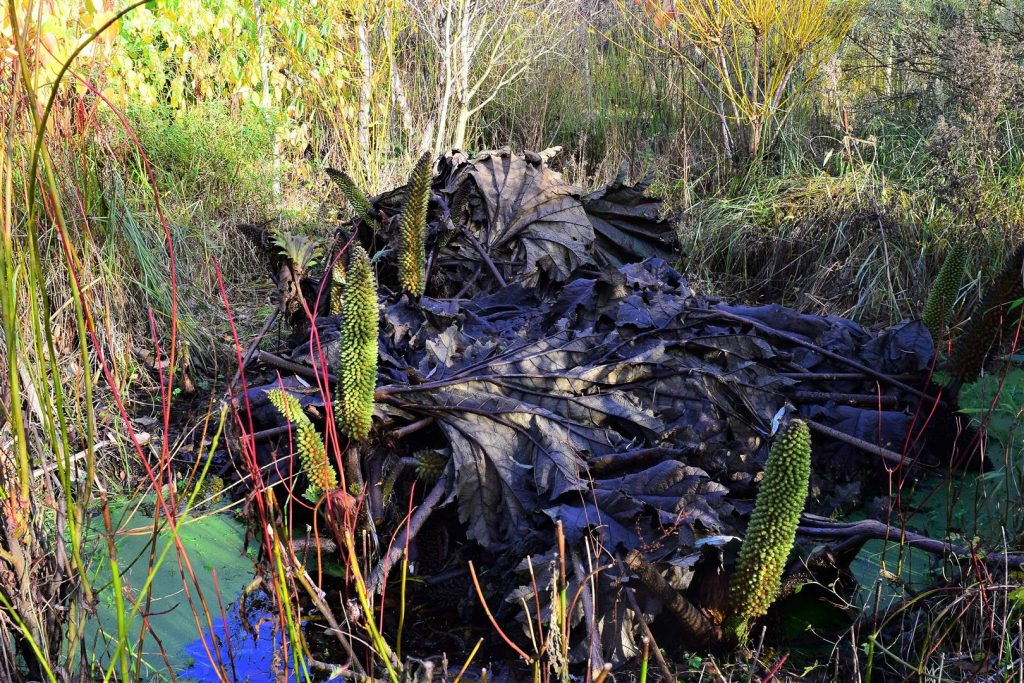
Cutting back the Gunerra in November
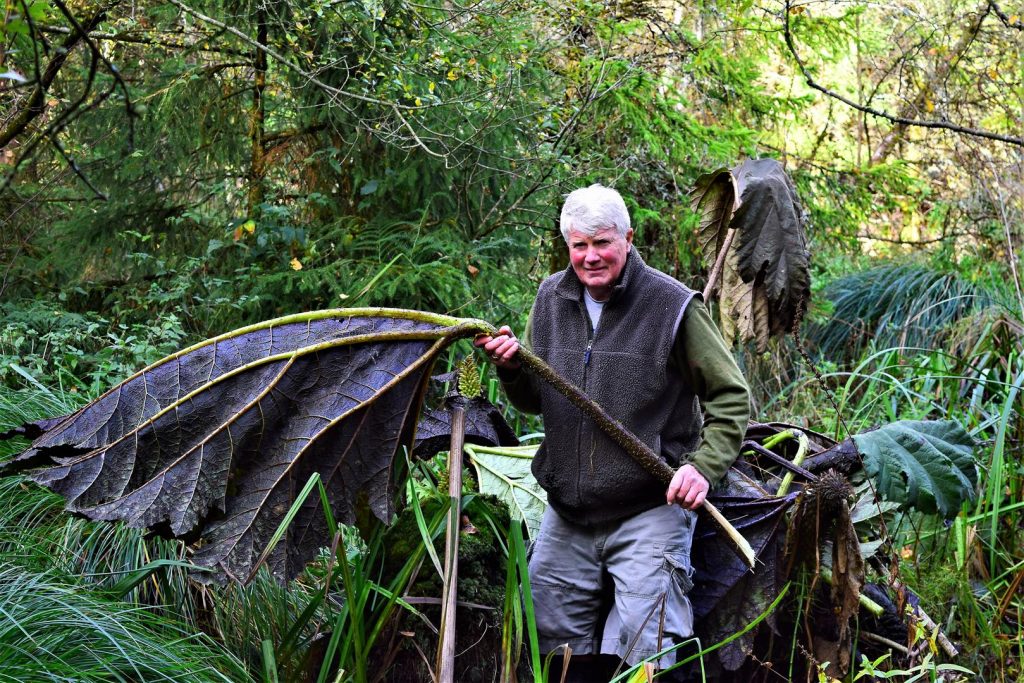
A huge event for me in the garden is early May when the gunnera leaves start to unfurl , I love these plants as they add a touch of the exotic but you need space for them to grow and it also is necessary to have dampish soil and they grow really well beside water but the gunnera itself doesent’t like it’s feet permanently in water but thrives where it’s roots can seek out water close by .
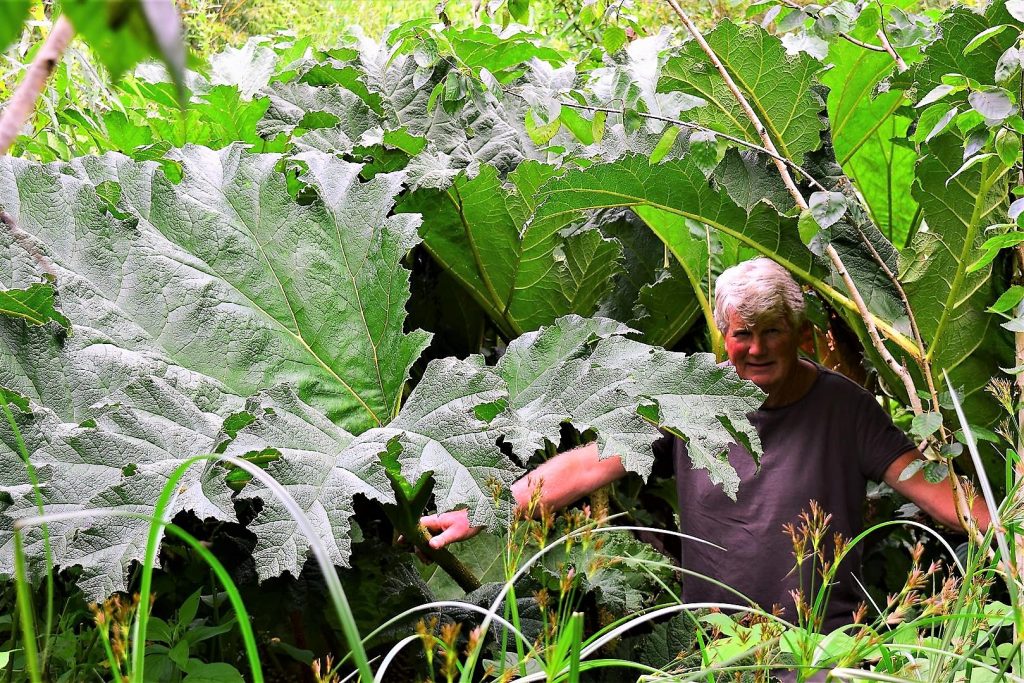
It seems like only yesterday we were enjoying the gunnera in all it’s glory and when back in early June I could shelter under their huge leaves while now there are just blackened leaves to remind us … a metaphor for life if one is being morbid … but there is no doubt that when gunerra play a large role in the garden as they do here they leave a huge hole when they leave us in November , still I wouldn’t be without them !
Although gunerra need water near by they can be grown in a dry garden however you will need to give a good hosing down with water every two days and in my previous garden in Rosslare I had huge gunerra in dry soil with regular watering but if you miss a period of watering in drought weather your gunerra will be sickly looking .
One from the archives of 32 years ago in Rosslare , my kids and how gunerra growing changed their lives !
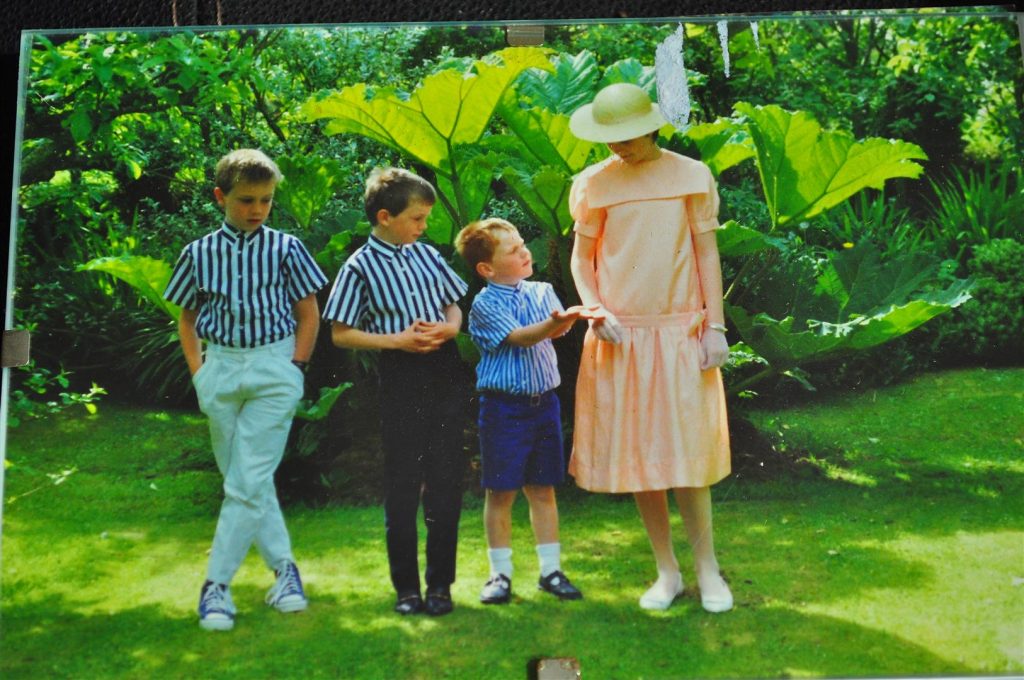
I am always on the lookout for unusual items that might find a home in the garden and over the years via auctions , visits to architectural salvage yards , donations from friends etc. we have some nice , well nice to us , items tucked away into corners of the garden and this last week I assembled some photos to a newly created web page on the www.petrovskagarden site which you can click on if you are curious .
Most days when I am in the garden I have a list of things to do but some days like today I am free to just wander around and it is a nice feeling to be so unstructured for a change so I found myself with a spare sack of daffodil bulbs and a spade strolling around and planting a few bulbs in areas where they will add some colour next March and April , they were spare bulbs so it was a real luxury just to dig them in here and there with no plan , no pressure or rush and while walking back I saw some clumps of bergenias that needed thinning last year but somehow I never got time to do it then but today well today I had all the time in the world !
Bergenias are a taken for granted perennial and can be quite difficult to find in garden centres nowadays as they flower only briefly with a pink flower on 12 inch stalks but as todays customers in garden centres demand substantial flowers so the humble bergenia is a plant cinderella who never gets to the ball and you rarely if ever see them featured in articles or generally raved about … well I have always loved them as they are a plant that is never fussy and will thrive in sun or shade , dry or wet soil with exotic names that are evocative of Empire , Elephant ears , Big Daddy , Chinese and Korean elephant ears but for me I love them best in shade where their thick glossy leaves light up any space . Bergenias are easy to propagate and rarely fail , just ease off a leaf from near the base with some root attached in the winter months anytime between November and April pop it in a pot with some compost and while there may be some die back on the leaf within a few weeks it will have taken strongly … a lot of the time I just transfer a rooted leaf direct into the location you want and as I say bergenias rarely fail to take .

I mentioned olive trees earlier and this month I got to tick a box on the bucket list by taking part in the olive harvest in Dalmatia . Croatian olive oil is getting great praise and mention on the internet lately and the oil is reckoned to be up there with some of the world’s best olive oil especially oil from Istria in the north of Croatia . Generally also you can trust Croatian olive oil to be pure and 100% Croatian origin unlike olive oil from Italy where as much as 50 % of Italian olive oil is fake and mixed with inferior quality oil and in some cases bulked up with vegetable oil and my own belief is that these days any product which is big commercially be it wine , olive oil , organic vegetables , where big business is involved you can’t trust it to be what it says on the label .
Snezana constantly reminds me that she being born in Macedonia has the olive oil culture in her DNA and of course I grew up in an era in Ireland in the 1950’s and 60’s where we bought our olive oil in a small 100ml glass bottle from the local chemist shop and we used it as a cure for ear ache … a heated spoonful was tipped into the ear by your mother while you lay on your side or were held down and then the ear was stuffed with cotton wool to keep the oil in there … cured all sorts of evils and softened up the wax in the ear also … as you can imagine we looked cool as school kids in St. Mary’s Primary School in Clonmel with cotton wool peeping out of our ears !!
Gornja Podgora is in Dalmatia just down from Split and for me Dalmatia is the best part of the Adriatic coast , I am not that keen on Istria as the region is too italianised for my taste .
We took over the olive trees , ten mature trees over 200 years old three years ago and have added five extra trees since then and a newly planted young olive tree takes up to six years in the ground to produce olives but olive trees can live almost forever and I have seen trees in Israel which are over five thousand years old. We pruned the trees hard the first year , kept them weed free and spread organic waste under them and this year layered the ground with bags of humus sourced locally from the sheep farms on Biokovo mountain , more sheep sh.t than humus actually , smells to high heaven but pure gold for the olive trees and the result that production has increased from eighty kilos two years ago to almost double that this year .
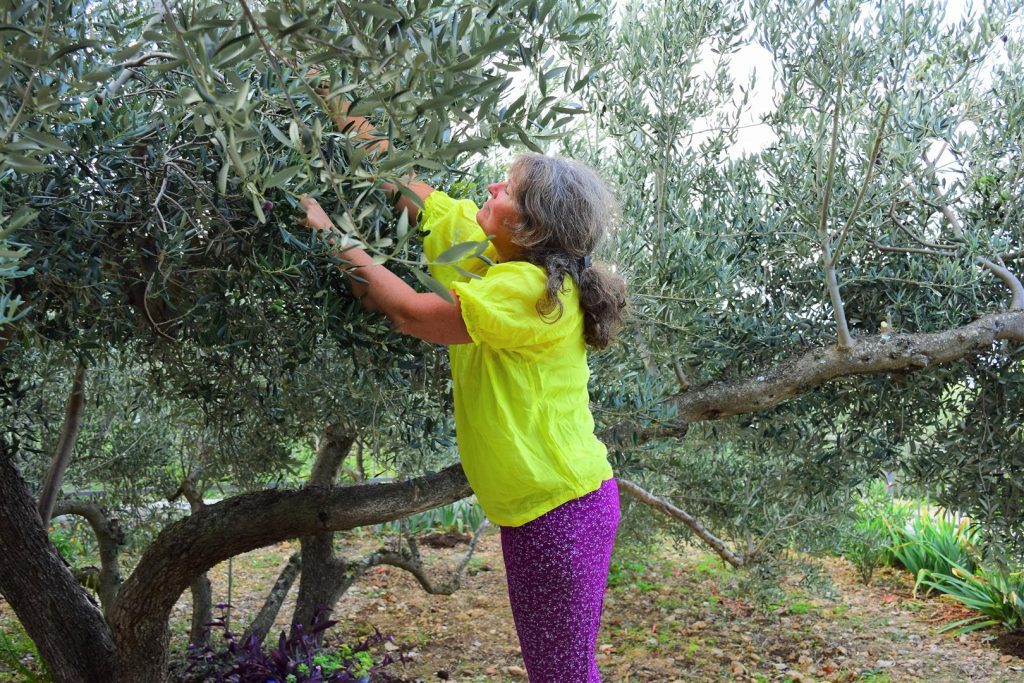
It took two full days for four of us to collect the olives and as were extra virgin pickers ourselves we hand picked every olive and if one dropped on the ground it was discarded but having seen the quality of what neighbouring pickers included in their baskets and which they have been doing for perhaps two thousand years we won’t be so picky next year ! Mentioning next year , one of the perils of growing olive trees is that there can be no fruit next year as each year you hope to avoid an infestation of olive fly , a little black fly that burrows into the olive and can destroy an entire crop and last year for example there was no olive oil harvest throughout Dalmatia … commercial growers can spray against the olive fly but Dalmatia’s olive trees are largely family owned usually spread over mountain slopes and hand picked as machinery can’t be brought in and also people there are very organically minded and don’t like using commercial sprays and it is not unusual for families to own up to 300 olive trees spread in small pockets across several locations … they are also very proprietorial about who owns what and you daren’t touch an olive that isen’t yours , very sicilian !
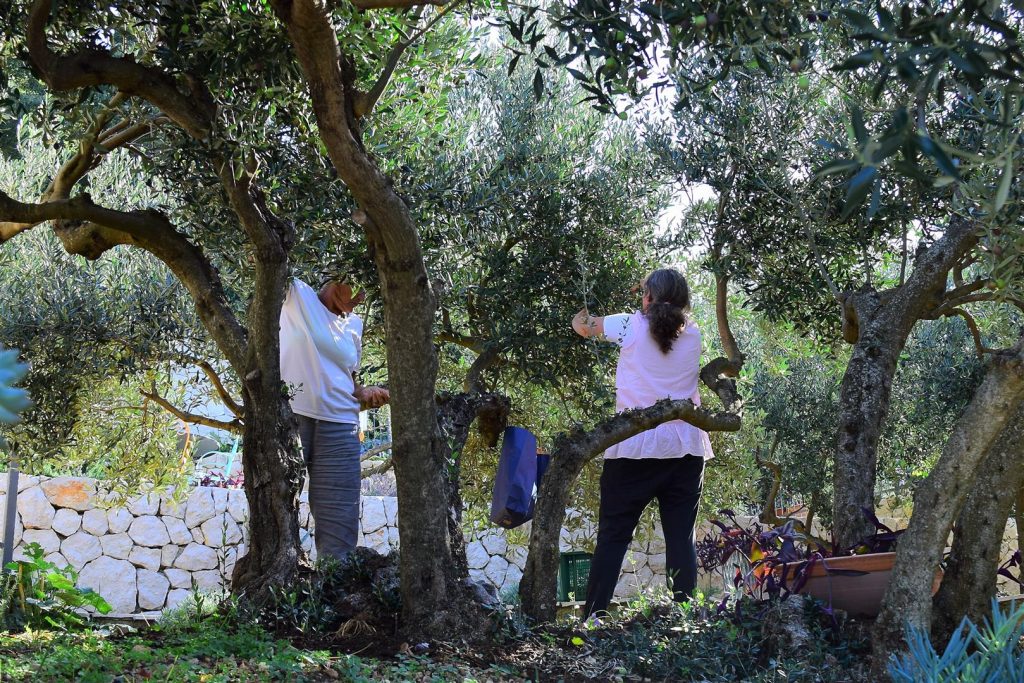
Olive picking is hard work leaving you with aching arms and fingers at the end of the day and after two days we loaded up the crates into the car and brought them to the local olive mill in Podgora where we had booked a slot for 11am and our little collection , all 145 kgs in six crates was treated with the same individual attention as people with two tons of olives and we strutted around with pride as authentic olive producers , looked condescendingly at what the neighbours were bringing in considering ourselves to have the best olives in Dalmatia like proud parents in a maternity ward , THE BEST OLIVES EVER !!

First the olives are weighed then when your time slot arrives they will have cleared through and cleaned the machinery after the previous customer and your olives are tipped into a holding cage where they are sieved and washed for any leaves or bits of branches attached , then the cargo moves through a centerfuge type washing system and after that the olives including the stones are ready for crushing , this system takes about an hour depending on the amount of olives you have and then the oil starts to flow into your 20 litre plastic containers … none of your fancy provence type poncy containers here in Dalmatia , olive oil production is a no nonsense event in Croatia one they have been doing without fuss or dressing up these past thousand years and one on which families harvest perhaps 300 litres of oil for their normal yearly consumption .. we with our expected 20 litre harvest had turned up with suitably designer type five litre glass dark bottles only to be told by the local guys to ditch these and opt for the more practical plastic 20 litre containers they all use … after collection the oil then has to sit for about three months to allow the sediment to settle to the bottom after which you can bottle and use it … done like we did it and indeed like small olive farmers all over the Mediterranean region do , a hand picked product with no additives or adulteration , there is nothing purer .
Weighing the olives October 2019
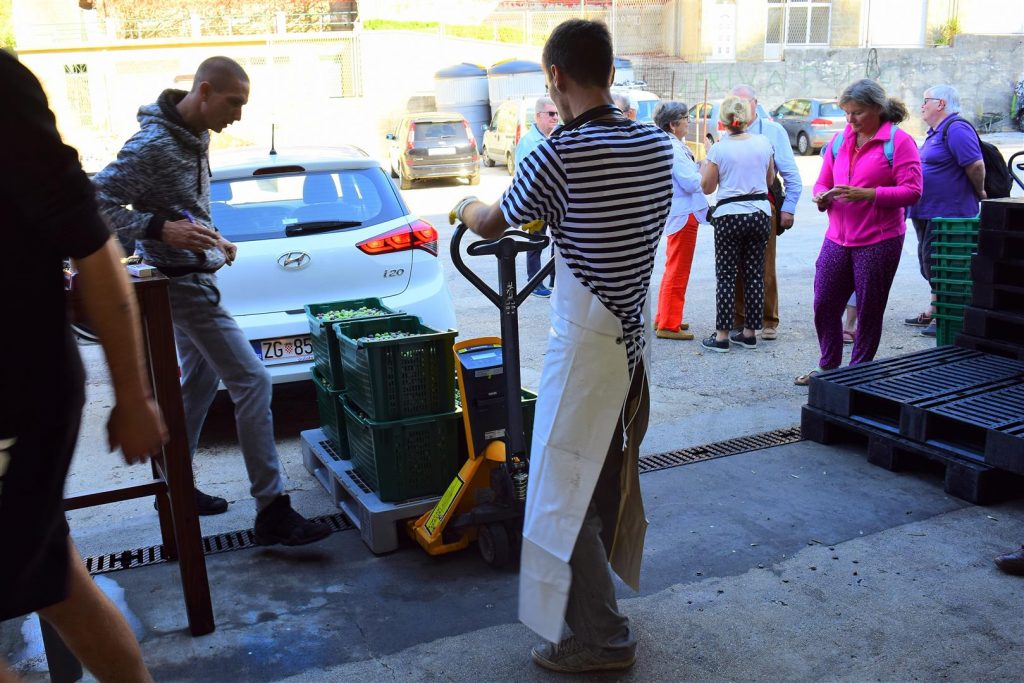
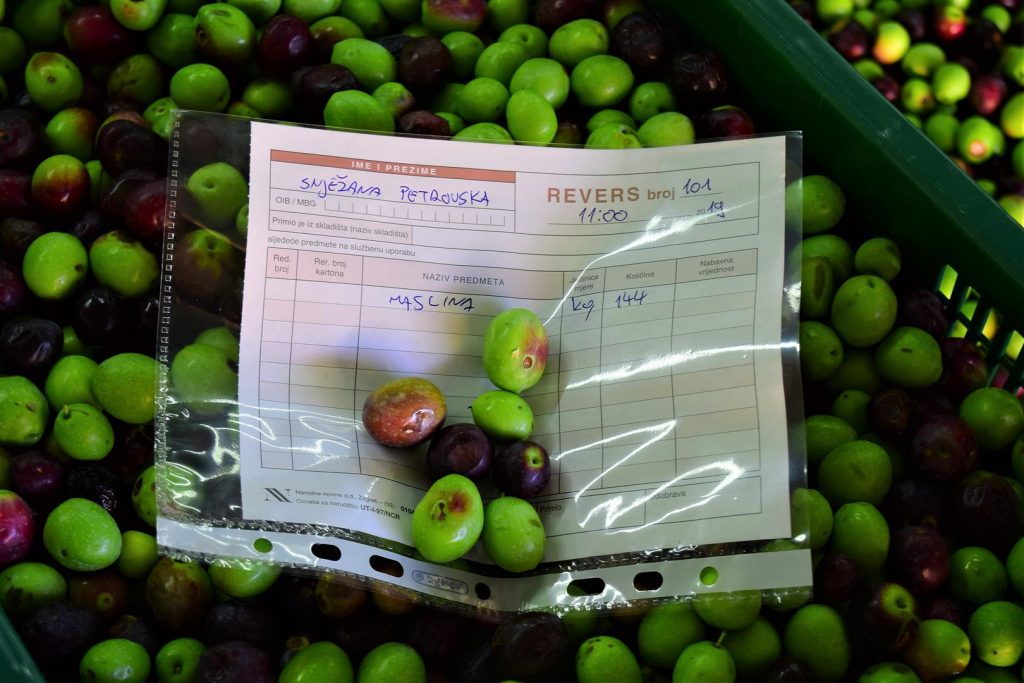
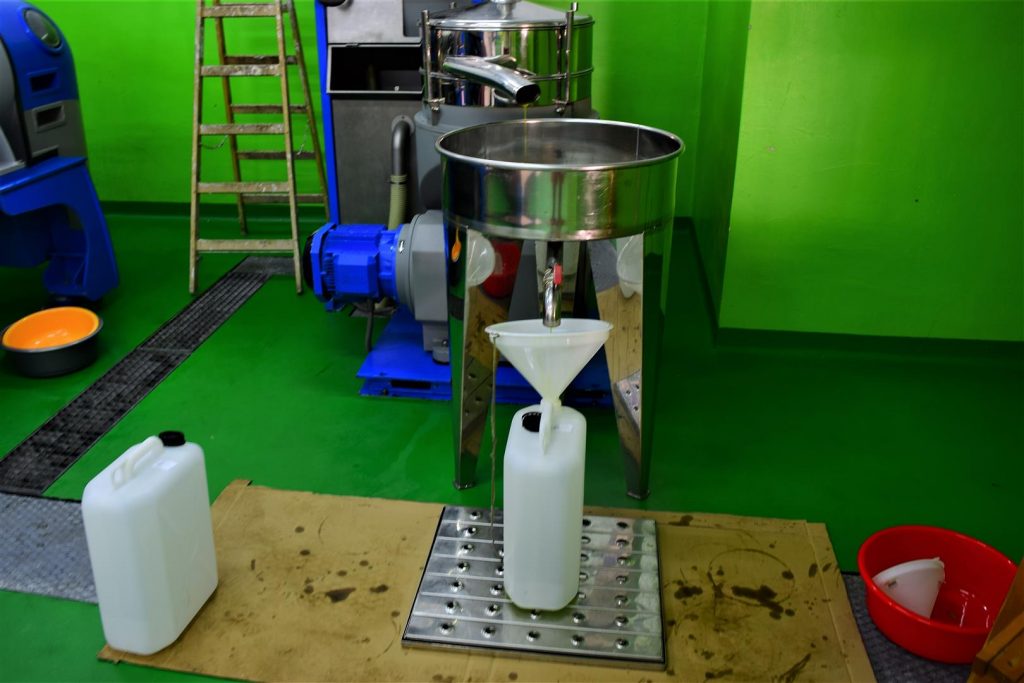
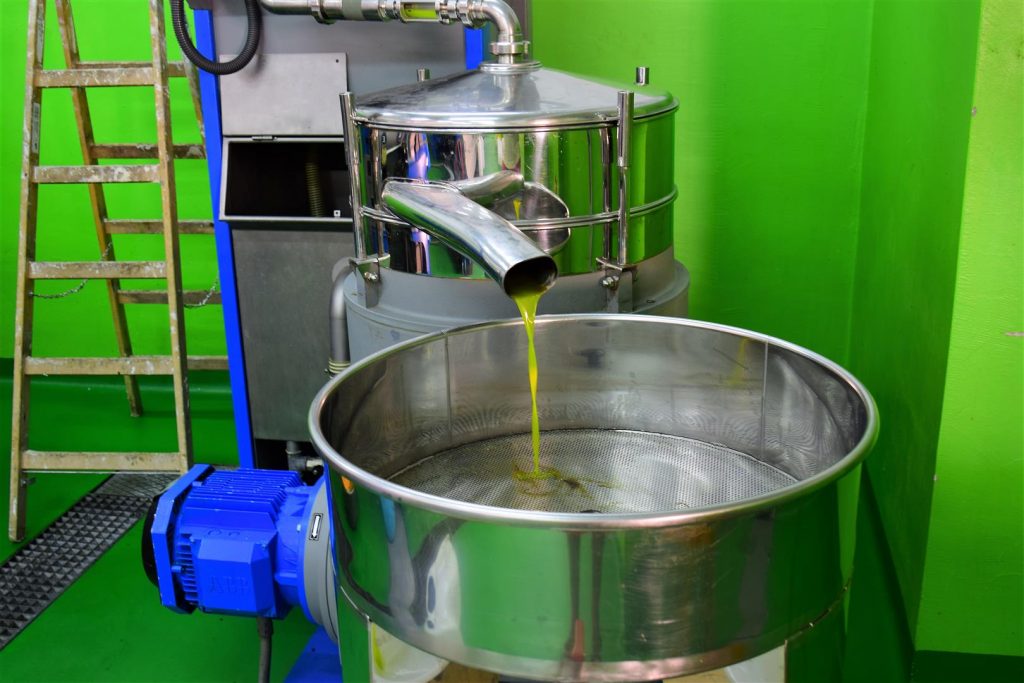

Having witnessed at first hand how important the olive collection is in Croatia and how closely the olive tree culture is ingrained in the local people and what a big part of their lives it is , I cannot imagine that any short cuts or corrupt practices would be tolerated there and olive oil is still mainly a family run operation .
Sadly however this is not the case elsewhere in the Mediterranean / Adriatic region where big commercial interests are concerned and olive oil production like any product big business is involved in is riddled with corruption and shady practices and dodgy dealing that include mixing with inferior cheap oil from the likes of Algeria and Tunisia to bulking up the product with vegetable oil … same as honey which is also a product subject to faking .
I would hate to end on that sour note so here is some more colour from the November garden !
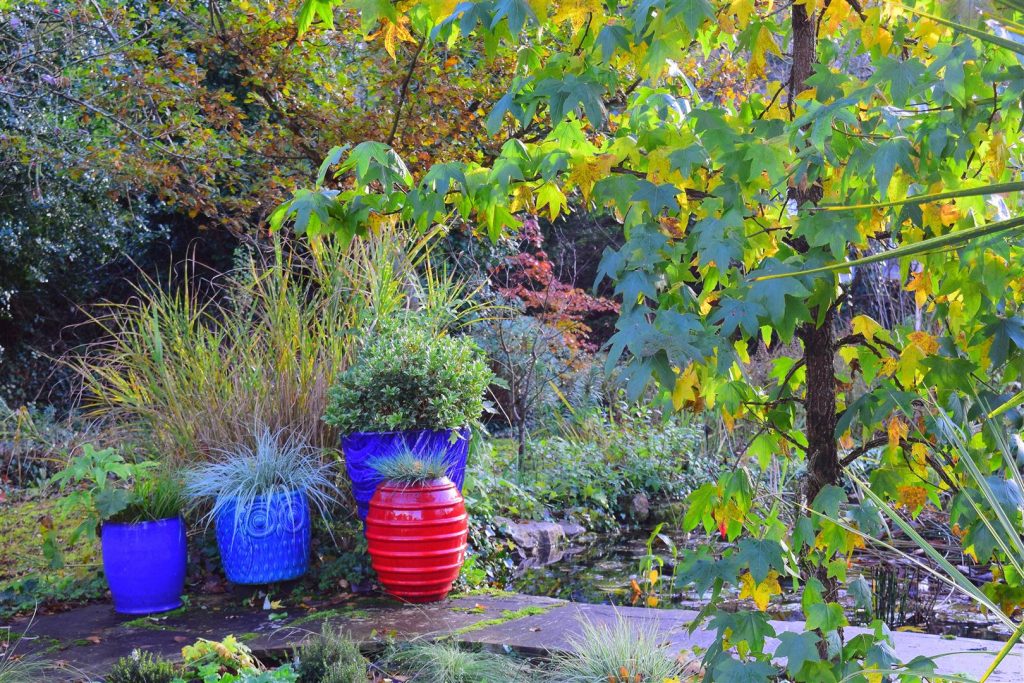
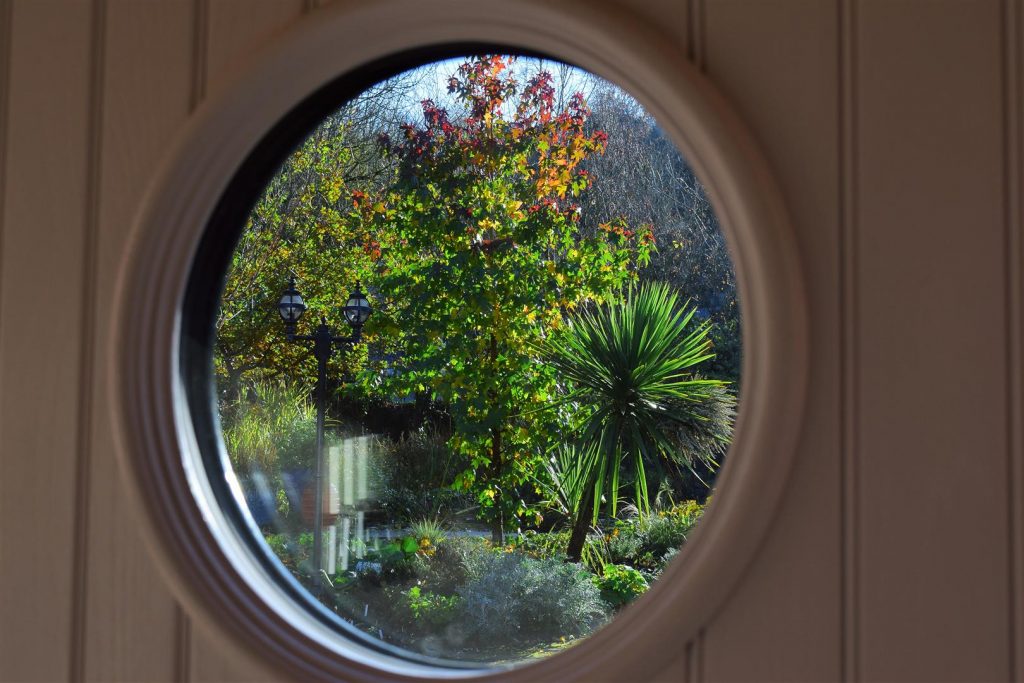


Leave a Reply